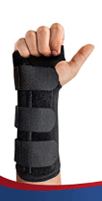Treatment
The following advice may help you to manage your symptoms if they are mild. You should seek advice from your healthcare practitioner after six weeks if your symptoms persist or become more severe.
Lifestyle changes
Sometimes, avoiding activities that aggravate the nerve may help to resolve the condition. Try and avoid repetitive hand or wrist movements. By pacing, or changing the way you carry out tasks, you may find you can manage your symptoms yourself. Have a discussion with your manager to see whether adjustments could be made to how you work, or changes, for example, to your computer workstation may help. You should ensure that you are able to drive safely.
Managing your health
If your carpal tunnel syndrome is more likely to be related to an underlying health condition, seek advice from your GP on how to best manage this to reduce your symptoms.
Hand exercises
Exercises can help to improve the movement of your wrist and hand. Try the following exercises three to four times per day:
Exercises for the fingers, hands and wrists | Versus Arthritis
Splinting
 Wearing a splint that rests the wrist in a neutral (straight) position might help relieve the symptoms occurring at night. In the short term, if your symptoms are brought on by particular activities, wearing a splint may help to remind you to try and bring in changes to the way you work. A pharmacist, doctor or hand therapist can advise you on which splints would be suitable, or advice can be found online. Wrist splints can be purchased privately online. Here is an example of an appropriate splint – the metal insert should be removed so that the wrist sits in a neutral (straight) position.
Wearing a splint that rests the wrist in a neutral (straight) position might help relieve the symptoms occurring at night. In the short term, if your symptoms are brought on by particular activities, wearing a splint may help to remind you to try and bring in changes to the way you work. A pharmacist, doctor or hand therapist can advise you on which splints would be suitable, or advice can be found online. Wrist splints can be purchased privately online. Here is an example of an appropriate splint – the metal insert should be removed so that the wrist sits in a neutral (straight) position.
 Wearing a splint that rests the wrist in a neutral (straight) position might help relieve the symptoms occurring at night. In the short term, if your symptoms are brought on by particular activities, wearing a splint may help to remind you to try and bring in changes to the way you work. A pharmacist, doctor or hand therapist can advise you on which splints would be suitable, or advice can be found online. Wrist splints can be purchased privately online. Here is an example of an appropriate splint – the metal insert should be removed so that the wrist sits in a neutral (straight) position.
Wearing a splint that rests the wrist in a neutral (straight) position might help relieve the symptoms occurring at night. In the short term, if your symptoms are brought on by particular activities, wearing a splint may help to remind you to try and bring in changes to the way you work. A pharmacist, doctor or hand therapist can advise you on which splints would be suitable, or advice can be found online. Wrist splints can be purchased privately online. Here is an example of an appropriate splint – the metal insert should be removed so that the wrist sits in a neutral (straight) position.